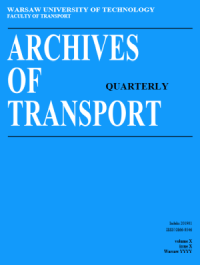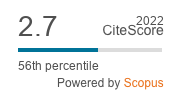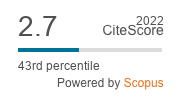The Revised Method for Calculating of The Optimal Train Control Mode
DOI:
https://doi.org/10.5604/01.3001.0013.6160Keywords:
conducting a train, running profile of the train, optimal control, driving simulators, electric traction motorsAbstract
Development of a method for calculating the optimal mode of conducting a train in terms of energy saving meet the safety requirements and schedules. The method of calculation must solve the assigned tasks without significant time spent on the calculation. To implement this method of calculation was used a simplified model of the train as a controlled system. The existing mathematical and algorithmic methods for solving isoperimetric problems of finding the optimal solution in the presence of restrictions on resources were the information base for methodology development. Scientific works of domestic and foreign scientists, professional periodicals, materials of scientific and practical conferences, methodical and normative materials, currently in force on Ukrainian Railways. The results of these studies were used to create simulators on the basis of computer technology for the training of locomotive drivers. The scientific novelty of the proposed calculation method consists in applying the simplified calculations of the status of the train as a controlled system, without the use of differential equations of motion that allows to significantly increase the speed of the calculations. This, in turn, will solve the problems of finding optimal control in real time, taking into account changing conditions during the movement of the train. The practical significance of the obtained results is the use of such a calculation method that does not require significant time for its implementation and can be used as a subsystem of the on-board train control system capable of performing calculations taking into account changes in the current train situation.
References
AKULOV, A. S., ZHELEZNOV, K. I., ZABOLOTNIY, O. M., URSULYAK, L. V., CHABANYUK, E. V., CHERNYAEV, D. V., SHVETS, A. O., 2017. Модульний тренажер машиніста [Modular Train Simulator]. Loko-motiv-inform, 7-8, pp. 42-49.
BELLMAN, R. E., 1960. Dynamic programming. Moscow: Foreign Literature Publishing House. 400 p.
BLOCHINAS, E., DAILYDKA, S., LINGAITIS, L., URSULIAK, L., 2016. Nestacionarieji ir kvazistatiniai geležinkelio traukinių judėjimo režimai [Non-stationary and quasi-static modes of train movement]. Vilnius: Technika. 168 p.
BLOKHIN, Y. P., ZHELEZNOV, K. I., UR-SULYAK, L. V., 2007. Вычислительный комплекс для решения задач безопасности и устойчивости движения подвижного состава железных дорог [Computer Complex for Solving Problems of Safety and Stability of Rolling Stock of Railways]. Science and Transport Progress, 18, pp. 106-114.
BURDZIK, R., NOWAK, B., ROZMUS, J., SŁOWIŃSKI, P., PANKIEWICZ, J., 2017. Safety in the railway industry. Archives of Transport, 44(4), 15-24. DOI: https://doi.org/10.5604/01.3001.0010.6158.
COLE, C., SPIRYAGIN, M., WU, Q., SUN, Y. Q., 2017. Modelling, simulation and applications of longitudinal train dynamics. Vehicle System Dynamics, 55:10, pp. 1498-1571, DOI: 10.1080/00423114.2017.1330484
CONTI, R., GALARDI, E., MELI, E., NOCCIOLINI, D., PUGI, L., RINDI A., 2015. Energy and wear optimisation of train longitudinal dynamics and of traction and braking systems. Vehicle System Dynamics, 53:5, pp. 651-671, DOI: 10.1080/00423114.2014.990466.
DOMIN, R., DOMIN, I., CHERNIAK, G., 2017. Estimation of dynamic performances of the safe operation of high-speed electric train. Archives of Transport, 41(1), 7-16. DOI: https://doi.org/10.5604/01.3001.0009.7374
GREBENYUK, P. T., DOLGANOV, A. N., NEKRASOV, O. A., LISITSYN. A. L., STROMSKY, P. P., BOROVIKOV, A. P., CHUKOVA, T. S., GRIGORENKO, V. G., PERVUSHINA, V. M., 1985. Правила тяговых расчетов для поездной работы [Rules of traction for train work]. Moscow: Transport. 289 p.
JACYNA, M., SZCZEPAŃSKI, E., IZDEBSKI, M., JASIŃSKI, S., MACIEJEWSKI, M., 2018. Characteristics of event recorders in Automatic Train Control systems. Archives of Transport, 46(2), 61-70. DOI: https://doi.org/10.5604/01.3001.0012.2103
OPALA, M., 2016. Study of the derailment safety index Y/Q of the low-floor tram bogies with different types of guidance of independently rotating. Archives of Transport, 38(2), 39-47. DOI: https://doi.org/10.5604/08669546.1218792.
SABLIN, O., KUZNETSOV, V., SHINKA-RENKO, V., Ivanov, A., 2017. Rational distribution of excess regenerative energy in electric transport systems on the basis of fuzzy logic application. Archives of Transport, 42(2), 53-63. DOI: https://doi.org/10.5604/01.3001.0010.0527.
SHVETS, A. A., ZHELEZNOV, K. I., AKULOV, A. S., ZABOLOTNY, A. N., CHABANYUK, E. V., 2016. Determination the permissible forces in assessing the lift resistant factor of freight cars in trains. Science and Transport Progress, 1 (61), pp. 189-192. DOI: 10.15802/stp2016/61045.
SUN, B., ZHANG, T., GAO, S., GE, W., LI, B., 2018. Design of brake force distribution model for front-and-rear-motor-drive electric vehicle based on radial basis function. Archives of Transport, 48(4), 87-98. DOI: https://doi.org/10.5604/01.3001.0012.8368.
URSULYAK, L. V., SHVETS, A. A., 2017. Improvement of mathematical models for estimation of train dynamics. Science and Transport Progress, 6 (72), pp. 67-79. DOI: 10.15802/stp2017/118002.
WANG, X., TANG, T., HE, H., 2017. Optimal control of heavy haul train based on approximate dynamic programming. Advances in Mechanical Engineering, 9 (4), pp. 1-15 DOI: 10.1177/1687814017698110.
Downloads
Published
Issue
Section
License
Copyright (c) 2024 Archives of Transport journal allows the author(s) to hold the copyright without restrictions.

This work is licensed under a Creative Commons Attribution 4.0 International License.











